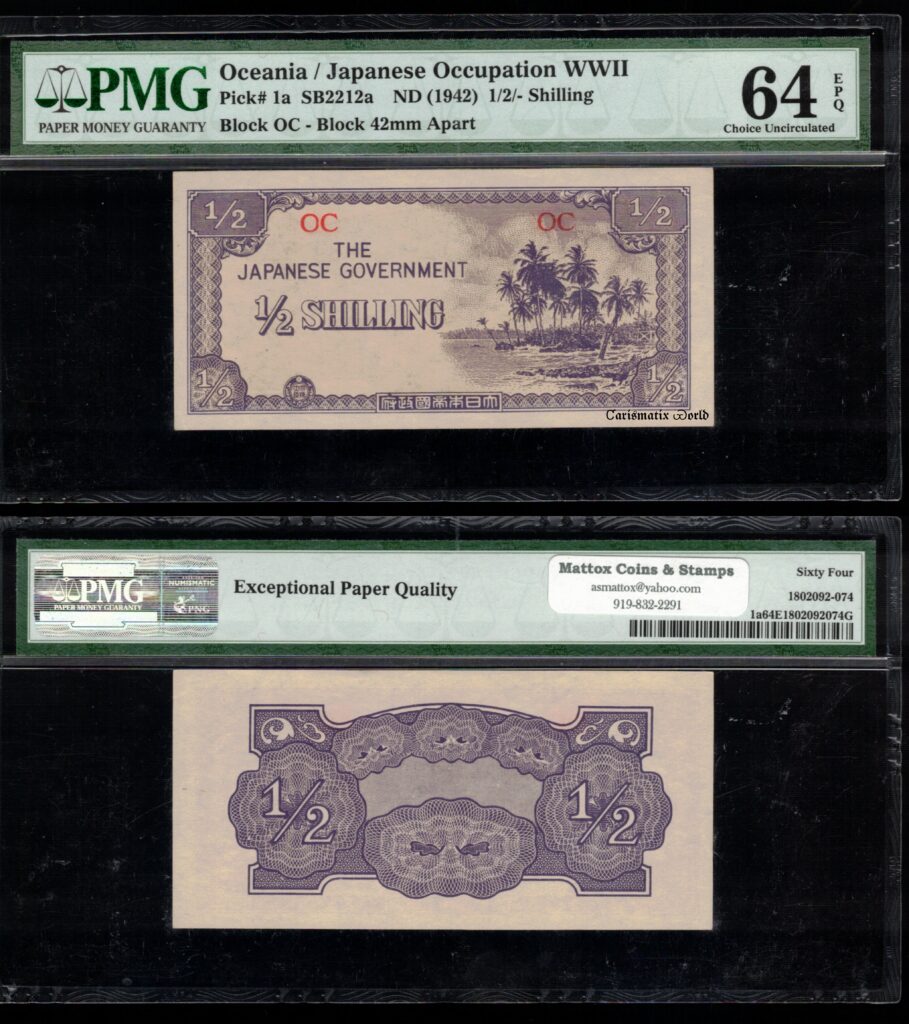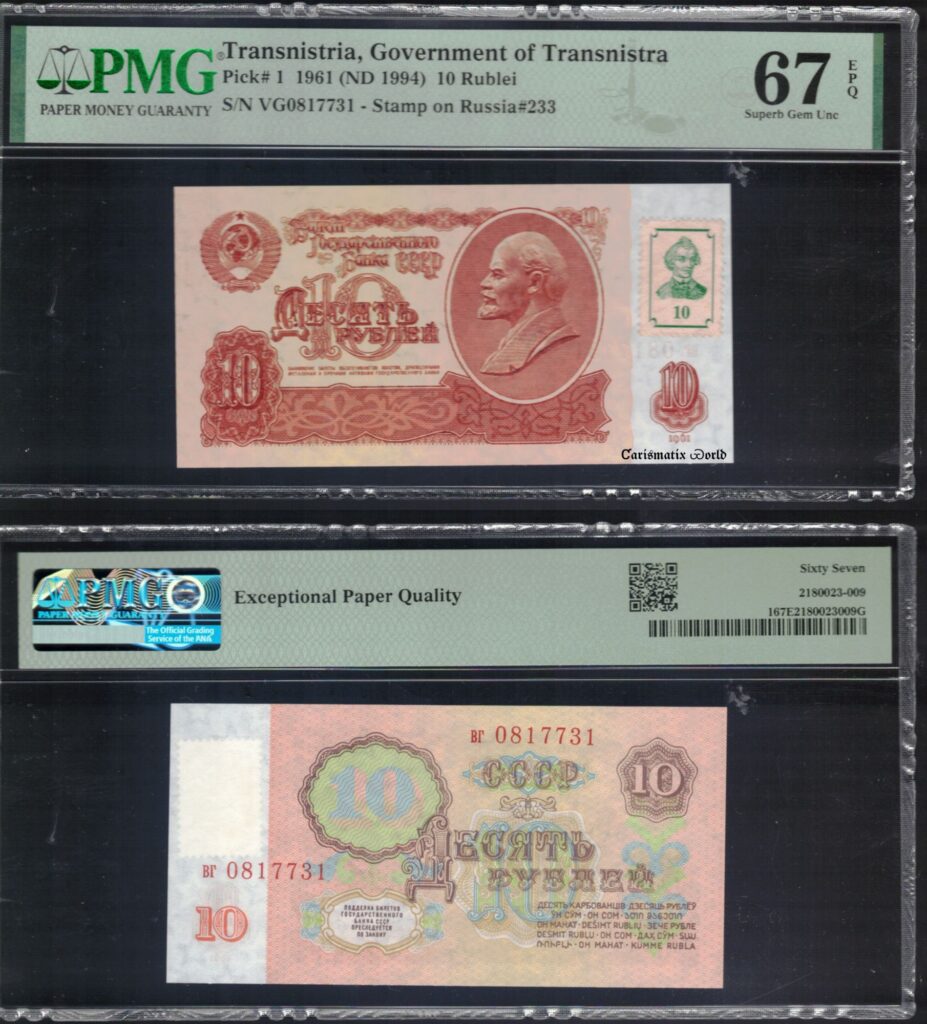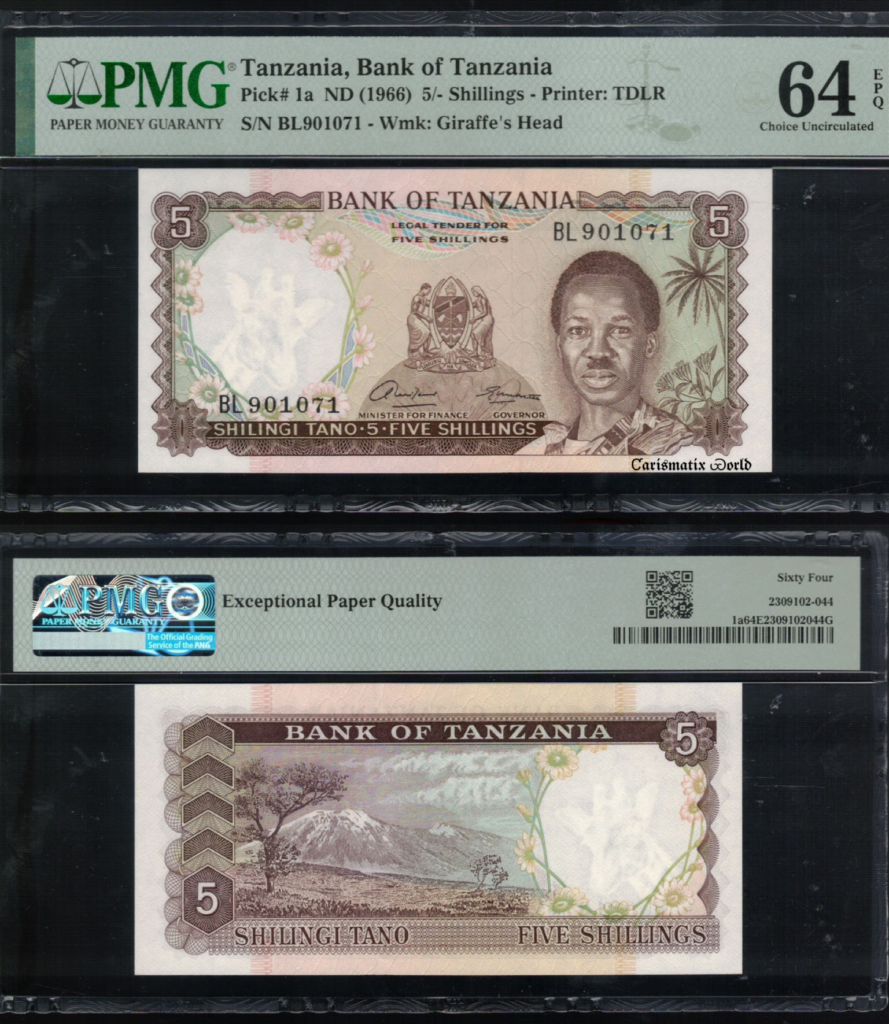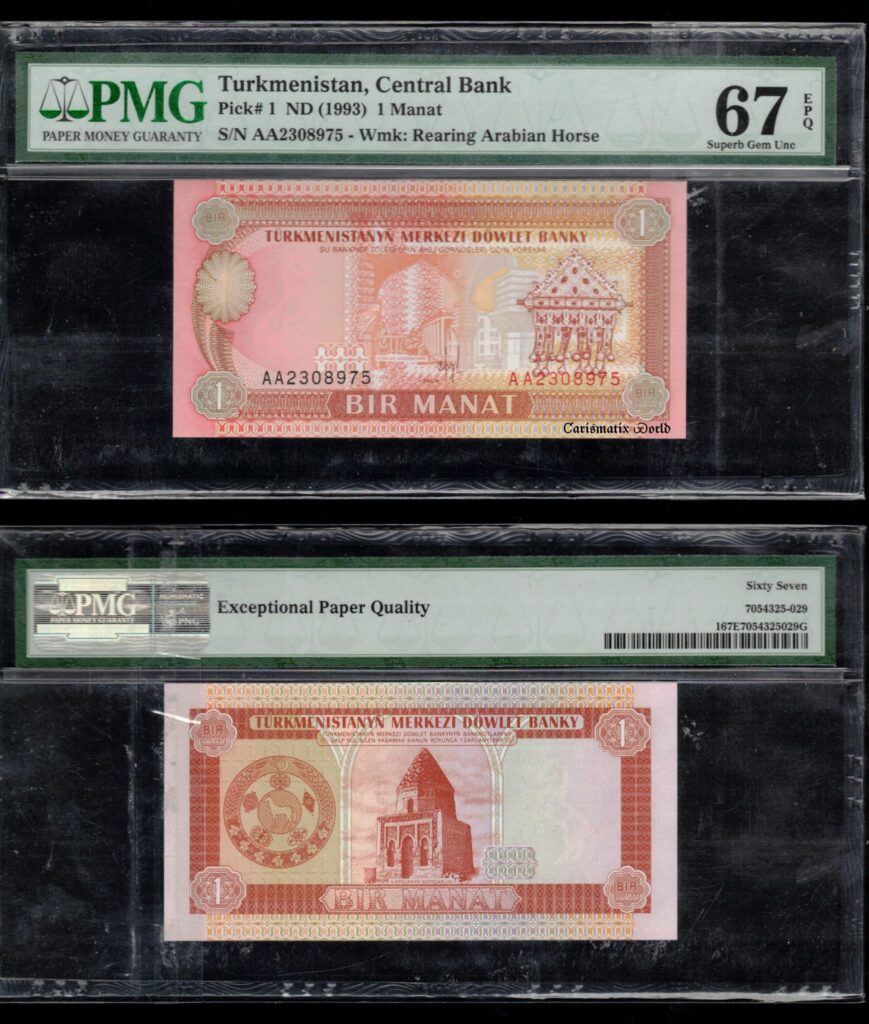
The Central Bank of Aruba (Centrale Bank van Aruba) introduced banknotes in denominations of 5, 10, 25, 50 and 100 florin and dated 1 January 1986.
The florin (Dutch: [floːˈrɪn]; abbreviation: Afl.; code: AWG) or Aruban guilder is the currency of Aruba. It is subdivided into 100 cents. The florin was introduced in 1986, replacing the Netherlands Antillean guilder at par. The Aruba currency exchange rate for U.S. dollars is Afl. 1.77 for cash and Afl. 1.78 for traveller’s checks. Most supermarkets and gas stations use the exchange rate of Afl. 1.75, while many restaurants and shops use the exchange rate of Afl. 1.80.


On June 2, 1974, Nu.1, Nu.5 and Nu.10 notes were introduced by the Royal Government of Bhutan, followed by Nu.2, Nu.20, Nu.50, and Nu.100 in 1978.
The Ministry of Finance issued its first banknotes in 1974 in denominations of Nu.1, Nu.5, Nu.10 and Nu.100. This was followed by the establishment of the Royal Monetary Authority of Bhutan as the central bank of Bhutan in 1982, which took over the authority to issue banknotes in 1983, replacing the authority of the Ministry of Finance.
The first notes, in denominations of 5/– and £1, were introduced on 29 January 1968. Despite not being recognised currency by the rest of the world when issued, the banknotes were afterwards sold as curios (typically at an eighth of their face value, or 2/6 sterling for Biafran £1) in British notaphily shops. The notes are now traded among banknote collectors at well above their original nominal value. The most commonly found notes are the 1968 and 1969 £1 notes, with the £10 note and all coins being rare.
All banknotes issued by the Bank of Biafra are undated, though the dates of issuance are known. All notes bear the signature of bank Governor Sylvester Ugoh and Director William Uzoaga.
The pound (symbol £) was the currency of the breakaway Republic of Biafra between 1968 and 1970.


The pula (also known as the Botswana dollar) is the currency of Botswana. It has the ISO 4217 code BWP and is subdivided into 100 thebe. Pula means “rain” in Setswana, because rain is very scarce in Botswana—home to much of the Kalahari Desert—and therefore valuable and a blessing. The word also serves as the national motto of the country.
A sub-unit of the currency is known as thebe, or “shield”, and represents defence. The names were picked with the help of the public. On 23 August 1976, the Bank of Botswana introduced notes in denominations of 1, 2, 5, and 10 pula; a 20 pula note followed on 16 February 1978.
Brunei’s first banknote series was issued in 1967 by the Government of Brunei, marking the country’s transition to its own currency. Prior to this, Brunei used the Malaya and British Borneo dollar. The 1967 series included denominations of 1, 5, 10, 50, and 100 ringgit, all featuring the portrait of Sultan Omar Ali Saifuddien III, who played a crucial role in modernizing Brunei.
The banknotes were printed by Bradbury Wilkinson & Co. (BWC) and featured intricate designs, security features, and cultural symbols. The 1-ringgit note, like the one shown in your image, depicts the Sultan in military attire on the front and the iconic Sultan Omar Ali Saifuddin Mosque on the back. This series laid the foundation for Brunei’s independent monetary system, which later evolved into the Brunei dollar (BND) that remains in use today.
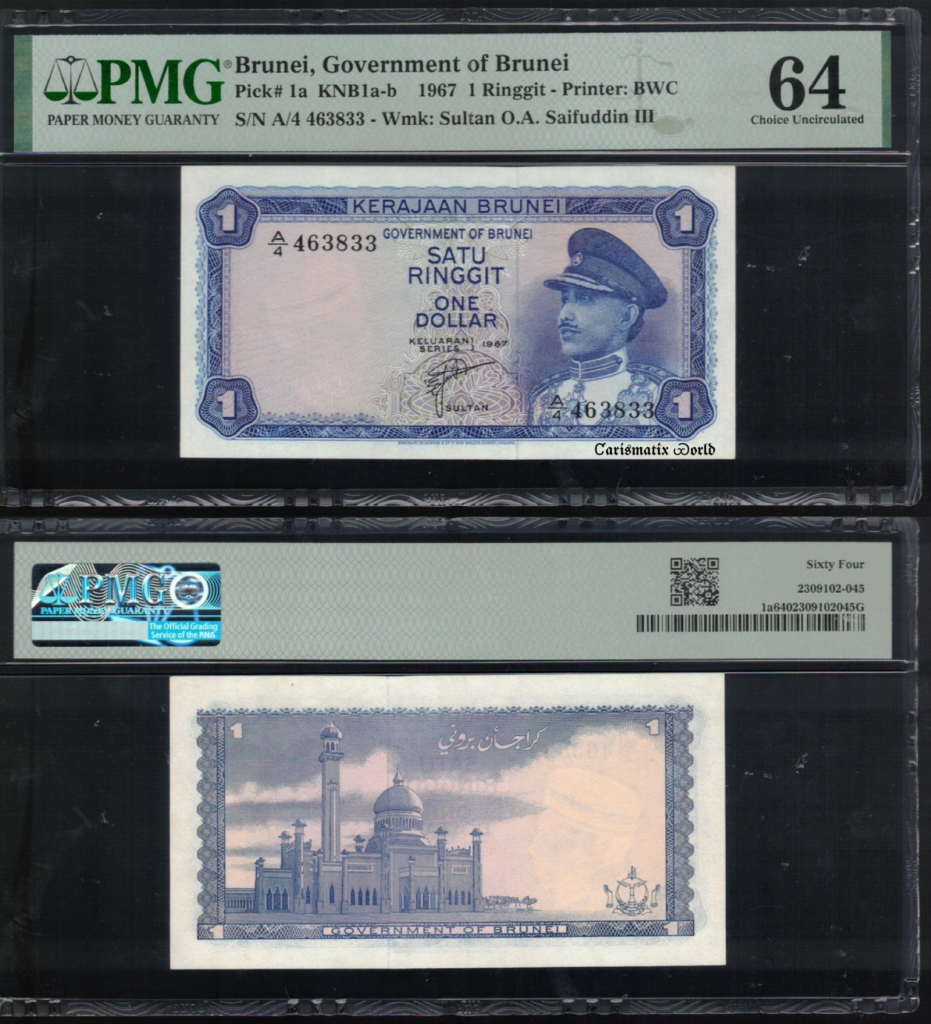

The first banknote series of the Cayman Islands was introduced in 1972 following the establishment of the Cayman Islands Monetary Authority. Before this, the islands used the Jamaican dollar as their primary currency. The 1972 series was denominated in Cayman Islands dollars (KYD) and included the $1, $5, $10, $25, $40, and $100 banknotes.
Design Features of the 1972 Series:
- The front of the banknotes prominently featured a portrait of Queen Elizabeth II, signifying the Cayman Islands’ status as a British Overseas Territory.
- The reverse side of each banknote depicted various aspects of Caymanian culture, history, and natural beauty, including marine life, local architecture, and ships, reflecting the islands’ maritime heritage.
- The notes were printed by TDLR, a well-known British security printing firm.
This first series established the foundation for the Cayman Islands’ independent monetary system, with later issues incorporating enhanced security features and updated designs.
The 1992 banknote series for the French Pacific Territories was a significant redesign of the previous series used in New Caledonia, French Polynesia, and Wallis and Futuna. The CFP franc (XPF) remained the official currency, issued by the Institut d’Émission d’Outre-Mer (IEOM).
1992 French Pacific Territories Banknote Series
- The series included 500, 1,000, 5,000, and 10,000 franc denominations.
- It featured enhanced security features and a more modern design, reflecting the culture, people, and natural beauty of the Pacific territories.
- The banknotes were bilingual, with text in both French and local languages.
Design Features:
- 500 francs: Featured a young Polynesian woman on the front, with a coastal village scene on the back.
Significance:
This series reinforced regional identity while maintaining economic stability under French administration.


The Gambia’s Banknotes (1965–1970) – The West African Pound Era
Before The Gambia introduced its own national currency in 1971, the country used the West African pound (pre-decimal currency) from 1965 to 1970.
Denominations in Circulation:
Coins were used for smaller values in pennies and shillings. The banknotes were issued in 5, 10, and 20 shillings, as well as 1 and 5 pounds.
Design Features:
- The front side of the banknotes featured a portrait of Queen Elizabeth II, as The Gambia was still a British colony until independence in 1965.
- The reverse side often included symbols of British colonial administration.
- The banknotes were printed in London by Thomas De La Rue.
Transition to the Gambian Dalasi (1971):
- After independence in 1965, The Gambia prepared to introduce its own currency.
- In 1971, the country officially adopted the Gambian dalasi (GMD), replacing the West African pound at a conversion rate of £1 = 5 dalasis.
- This change aligned The Gambia with a decimal-based currency system.
During 1965–1970, The Gambia remained in transition, still using British colonial currency until it established full monetary independence in 1971.
Ghana’s Banknotes in 1963
In 1963, Ghana was using the Ghanaian pound (GHP), which was the country’s official currency from 1958 to 1965, before switching to the cedi (GHS) in 1965.
Background:
- Ghana gained independence from Britain in 1957, and in 1958, the country replaced the British West African pound with the Ghanaian pound as its first independent currency. The Bank of Ghana was responsible for issuing banknotes.
1963 Ghanaian Pound Banknote Series:
The banknotes issued during this period came in 10 shillings, £1, and £5 denominations. Design Features:
- Front Side: Featured a portrait of Dr. Kwame Nkrumah, Ghana’s first President and a key figure in the country’s independence. Included the Bank of Ghana seal and intricate designs for security.
- Reverse Side: Depicted important national landmarks, symbols of industry, and agriculture to reflect Ghana’s growing economy.
Transition to the Ghanaian Cedi (1965):
The 1963 banknotes were replaced by new cedi-denominated notes, further marking Ghana’s break from its colonial past.
In 1965, Ghana switched from the pound-shilling-pence system to a decimal currency system, introducing the cedi (GHC), where £1 = 2 cedis.
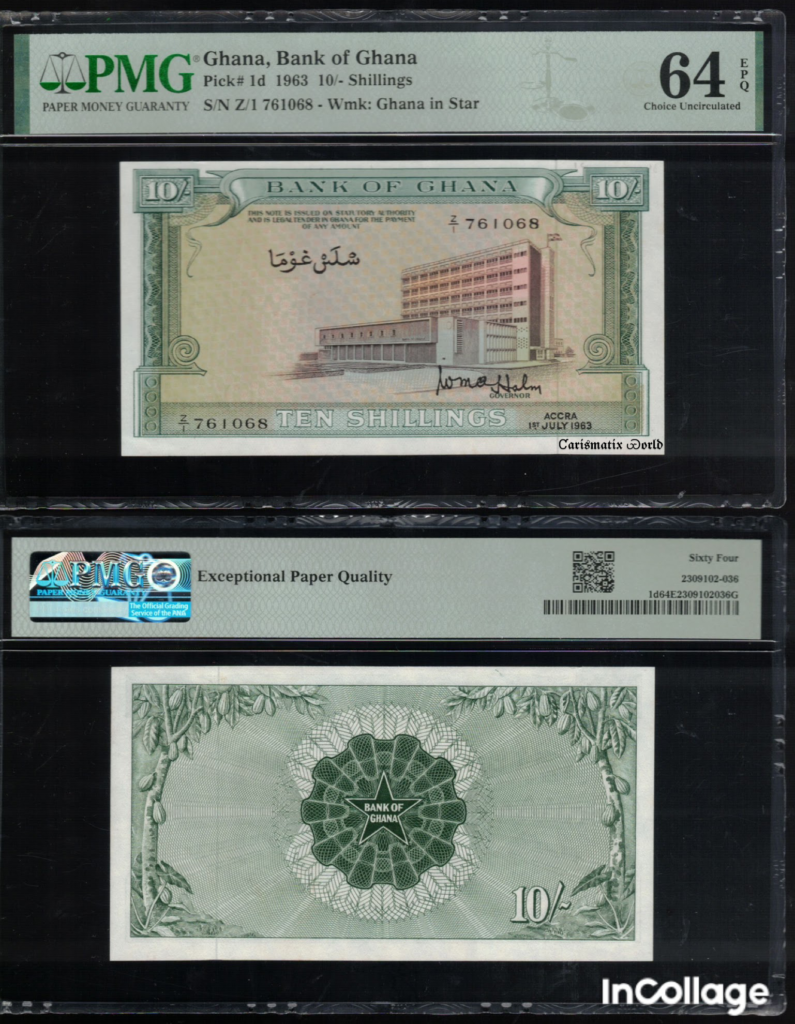

Guinea-Bissau’s First Banknote Series (1975)
In 1975, following independence from Portugal, Guinea-Bissau introduced its own national currency, the Guinea-Bissau peso (GWP), replacing the Portuguese escudo (PTE).
Background: Guinea-Bissau gained independence from Portugal on September 24, 1973, but it was officially recognized in 1974 after the fall of Portugal’s dictatorship. The country needed a new currency to solidify its economic independence, leading to the introduction of the peso in 1975. The first series included 50, 100, 500, and 1,000 pesos. Issued by the Banco Nacional da Guiné-Bissau. Printed by foreign security printing companies.
Design Features:
- Front Side: Featured Amílcar Cabral, the revolutionary leader who led Guinea-Bissau’s struggle for independence. Included national symbols, such as the coat of arms and patterns representing the country’s cultural heritage.
- Reverse Side: Depicted agriculture, fishing, and industrial development, reflecting the country’s economic priorities.
Transition to the West African CFA Franc (1997): The Guinea-Bissau peso suffered from high inflation. In 1997, Guinea-Bissau joined the West African Economic and Monetary Union (UEMOA) and adopted the West African CFA franc (XOF), replacing the peso at a rate of 1 XOF = 65 pesos.
The 1975 banknotes were the first step in Guinea-Bissau’s financial sovereignty, marking an important phase in its post-independence history.
Allied Irish Banks (AIB) Northern Ireland Banknotes – 1982
In 1982, Allied Irish Banks (AIB), operating in Northern Ireland, issued its own banknotes as part of the local currency system. AIB was granted the right to issue pound sterling (GBP) banknotes in Northern Ireland, continuing the tradition of unique banknotes from local banks.
Key Details of 1982 AIB Banknotes:
Denominations Issued: £1 (phased out in later years), £5, £10, £20, £50 (less common).
Design Features:
- Front Side: Featured the AIB logo, incorporating a traditional design with symbols reflecting Irish heritage. Included detailed, colorful patterns and watermarks as security features. The bank’s name, Allied Irish Banks Limited, was prominently displayed.
- Back Side: Often depicted important cultural or historical references, such as Irish landscapes or emblems representing Northern Ireland. Unique to AIB, the designs aimed to highlight the shared Irish identity while adhering to British currency standards.
Legal Status: AIB’s banknotes were legal tender in Northern Ireland, but like other Northern Irish notes, they were not always widely accepted elsewhere in the UK. They had the same value as Bank of England notes but were more regional in circulation.
Significance of the 1982 Series: This series continued the Provincial Bank of Ireland’s tradition, which merged into AIB in 1970. It represented a balance between Northern Ireland’s economic integration with the UK and its unique regional identity.
Today, Allied Irish Banks is no longer issuing banknotes in Northern Ireland, as it ceased this practice in 1996, but its older notes remain collectible.
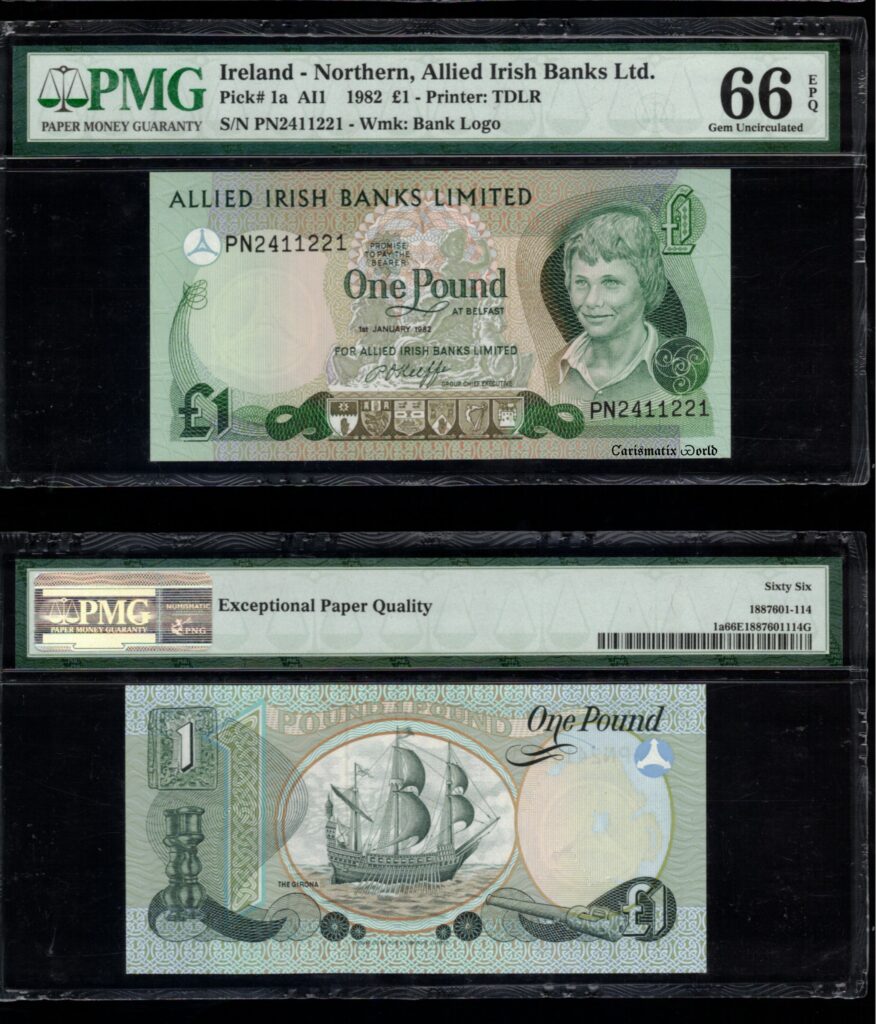
Ivory Coast Banknotes During the French Administration (1917)
Historical Context (1917):
- World War I Impact:
During the war, currency shortages were common due to economic pressure on France. Despite this, the Banque de l’Afrique Occidentale ensured that French West Africa’s currency needs were met. - Economic Activity in Ivory Coast:
The Ivory Coast was a growing exporter of agricultural products (e.g., cocoa and coffee) under French colonial rule, and the CFA franc facilitated trade within the colonial economy.

In 1917, under French administration, the Ivory Coast (Côte d’Ivoire) used the same currency as the other colonies in French West Africa. The banknotes issued at the time were part of the broader Franc des Colonies Françaises d’Afrique (CFA franc) system managed by the Banque de l’Afrique Occidentale (BAO). These banknotes were not specific to the Ivory Coast but were used across all French West African colonies.
Design Features of 1917 French West African Banknotes:
Front Side (Obverse): Displayed “Banque de l’Afrique Occidentale” as the issuing authority. Featured allegorical representations of French colonial power, trade, agriculture, and industry. Included the denomination in French and often included a small note about its legal tender status within French West Africa. Incorporated vivid, intricate patterns for security purposes.
Back Side (Reverse): Often simpler in design compared to the obverse, featuring decorative patterns and sometimes images symbolizing the colony’s natural resources (e.g., cocoa, palm oil, or timber) or cultural heritage.
Key Details About These Banknotes:
- Usage:
These notes circulated across the French West African colonies, including Ivory Coast, Senegal, Mali, Burkina Faso, Benin, and others. The design and issuing authority were standardized for the region. - Material:
Printed on high-quality paper with basic security features for the time, including watermarks and detailed engravings. - Printing Authority:
The notes were printed in Paris, France, by companies like Banque de France or private security printers contracted by the French government.
Laos 1957 banknotes are collectible pieces of currency that hold historical significance. Here’s some key info using popular terms:
- Issued By: The banknotes were issued by the Kingdom of Laos in 1957. Back then, Laos was transitioning after gaining independence from France in 1954.
- Currency Name: The currency was called the Kip. It replaced the French Indochinese piastre.
- Designs and Denominations:
- The 1957 series featured denominations like 1 Kip, 5 Kip, 10 Kip, and higher values.
- Common designs include Laotian cultural symbols, traditional attire, and rural life scenes, showing Laos’ heritage.
- Language: The notes often had text in both Lao and French, as French influence was still present during this time.
- Collectors’ Value: These notes are now considered rare and are sought after by collectors. The value depends on:
- Condition: Crisp, uncirculated notes are worth more.
- Rarity: Certain denominations and series might be harder to find.
- Visual Features: They typically have colorful designs with intricate details, showcasing Laos’ unique identity.
If you’re into currency collecting or history, these banknotes are a fascinating piece of mid-20th-century Laos! Want info on specific notes or how to value them?

Lesotho’s 1979 banknotes are part of the country’s early monetary history after it established its own currency. Here are the key points about these notes:
1. Issued By: The banknotes were issued by the Central Bank of Lesotho.
2. Currency Name: The official currency of Lesotho is the Loti (plural: Maloti), introduced in 1979, replacing the South African Rand as the main currency (though the Rand is still accepted).

3. Denominations: The 1979 series featured banknotes in the following denominations: 2 Maloti , 5 Maloti , 10 Maloti , 20 Maloti
4. Designs and Features:
- Portrait: Most banknotes from this series prominently feature King Moshoeshoe I, the founder of the Basotho nation.
- Reverse Designs: The back often includes scenes representing Lesotho’s culture, economy, and landscapes, such as:
- Agriculture
- Rural village life
- Basotho horses and traditional hats (Mokorotlo).
- The colors and patterns were vibrant, reflecting the national identity.
5. Language: The notes had text in both English and Sesotho, the official languages of Lesotho.
6. Collectors’ Value:
- Historical Significance: As the first independently issued currency, these notes hold historical and numismatic value.
- Condition: Uncirculated or well-preserved notes fetch higher prices in collector markets.
- Rarity: Specific denominations or serial numbers might be rare and more valuable.
7. Transition Period:
The South African Rand was used alongside the Loti after its introduction, and this dual-currency system remains to this day.
These 1979 banknotes are a reflection of Lesotho’s cultural pride and sovereignty. Are you looking for images, valuations, or detailed descriptions of a specific denomination?
Liechtenstein’s 1920 banknotes are a fascinating piece of monetary history from a small European principality. Here’s a breakdown of key information about them:
1. Issued By: The banknotes were issued by the Principality of Liechtenstein, marking a unique period when the country briefly used its own emergency currency due to financial crises post-World War I.
2. Currency Name: The currency used was the Liechtenstein Krone (Kronen), which was tied to the Austro-Hungarian currency system. This was before the Swiss Franc became the country’s primary currency in 1924.
3. Denominations: The 1920 emergency issue included low-value denominations such as: 10 Heller, 20 Heller, & 50 Heller . These were more like “emergency money” (Notgeld) issued to address a shortage of coins and currency in circulation.
4. Design and Features: The banknotes had simple designs, reflecting the urgency of the economic situation. Printed on basic paper, they featured: Text in German (official language of Liechtenstein). Denominations prominently displayed. The official seal or coat of arms of Liechtenstein in some cases.
5. Historical Context: These notes were issued during the aftermath of World War I, when the Austro-Hungarian Krone had lost its value, causing widespread financial instability in countries that had used the currency. Liechtenstein issued these emergency notes to ensure continued commerce and trade within the principality
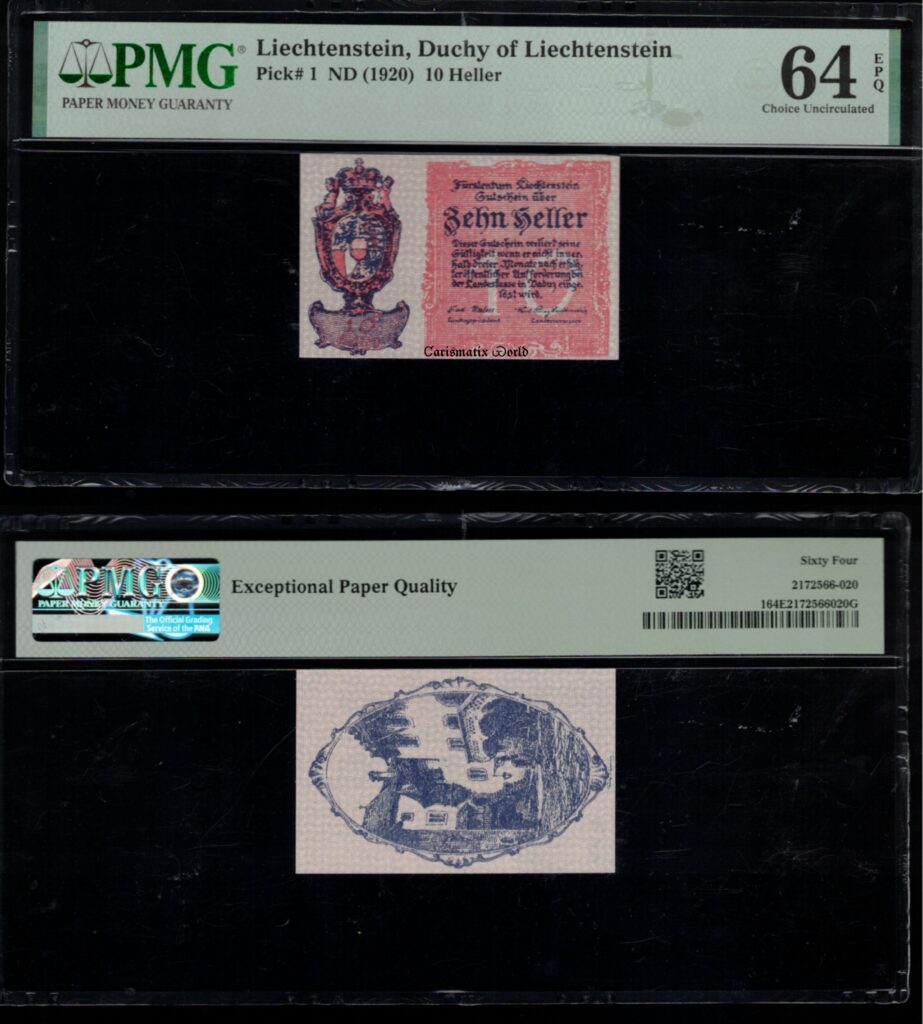
6. Collectors’ Value:
- Rarity: These notes are rare since they were produced in limited quantities and were only in use for a short time.
- Condition: Well-preserved notes are highly collectible.
- Historical Appeal: As an example of early 20th-century emergency currency, these notes are particularly interesting to numismatists.
7. Transition to Swiss Franc: By 1924, Liechtenstein officially adopted the Swiss Franc as its currency, ending the use of the Krone and emergency notes.
Would you like more details on specific notes, their market value, or historical significance? Let me know!
Malaysia’s banknotes from 1967–1972 are highly significant, as they represent the first series of currency issued by Malaysia after its independence in 1957 and the formation of Malaysia in 1963. Here’s a detailed breakdown:
1. Issued By: The banknotes were issued by Bank Negara Malaysia (Central Bank of Malaysia).
2. Currency Name: The currency was the Malaysian Dollar (commonly referred to as Ringgit today), abbreviated as $ or M$ during this period. The symbol “RM” replaced “M$” later.
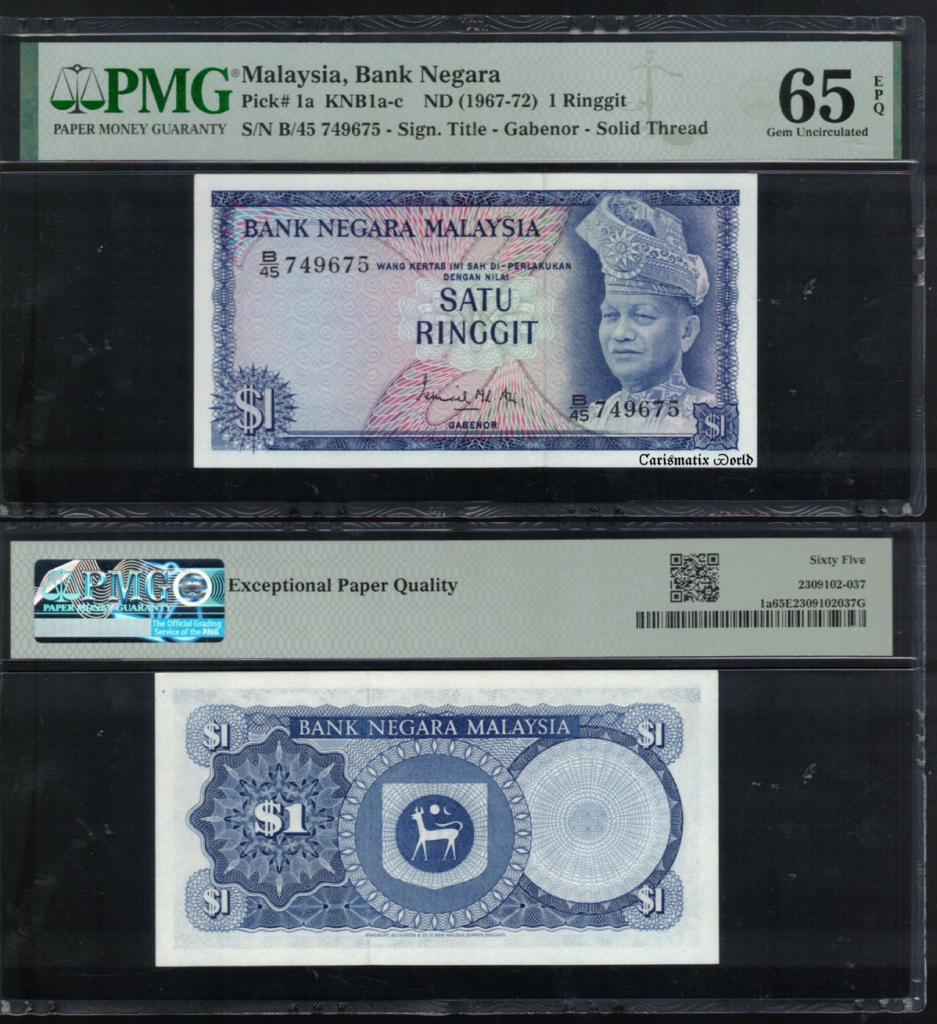
3. Language: The notes included Malay (Jawi script) and English, emphasizing Malaysia’s multilingual and multicultural heritage.
4. Historical Context: These banknotes marked Malaysia’s shift away from the Malaya and British Borneo currency and were designed to reflect national identity and sovereignty. The notes were in circulation during Malaysia’s early years as a newly independent nation.
5. Collectors’ Value:
- Condition: Crisp, uncirculated notes are highly valuable.
- Serial Numbers: Rare or unique serial numbers (e.g., AA000001 or solid numbers like 888888) fetch premium prices.
- Rarity: Higher denominations like $1,000 are extremely rare and valuable today.
6. Transition to the Second Series: In 1982, Malaysia introduced its second series of banknotes, featuring updated designs and security features. However, the 1967–1972 series remains a collector’s favorite due to its historical significance.
Let me know if you want specific details on any denomination or help identifying their current market value!
Mauritania’s 1973 banknotes are an important part of the country’s history, as they were among the first series of banknotes issued after Mauritania transitioned to its own currency. Here are the details:
1. Issued By: The notes were issued by the Central Bank of Mauritania (Banque Centrale de Mauritanie).
2. Currency Name: The currency is the Ouguiya (UM), introduced in 1973, replacing the CFA Franc. One Ouguiya was subdivided into 5 Khoums instead of the standard decimal system.
3. Denominations : The first series of 1973 banknotes included the following denominations: 100 Ouguiya, 200 Ouguiya & 1,000 Ouguiya
4. Designs and Features:
- Obverse (Front): Depicted symbols of Mauritanian culture and economic activities, such as: Camels, representing the nomadic way of life. Fishing scenes, reflecting the importance of the fishing industry. Agricultural motifs, highlighting farming and the use of traditional tools.
- Reverse (Back): Showcased Islamic patterns and architectural elements, tying to Mauritania’s identity as an Islamic Republic.
- Language: The text was written in both Arabic (official language) and French (widely used at the time).
5. Historical Context: Introduction of the Ouguiya:
Mauritania’s move to its own currency marked its economic independence from the CFA Franc, which was used in many West African countries tied to France. These notes were the first official national banknotes, symbolizing Mauritania’s sovereignty.
6. Collectors’ Value:
Historical Appeal: These notes are significant as the first issued by independent Mauritania.
Rarity: Notes from 1973 are increasingly rare, especially in higher denominations and uncirculated condition.
Condition: Well-preserved or uncirculated notes fetch high prices among collectors.
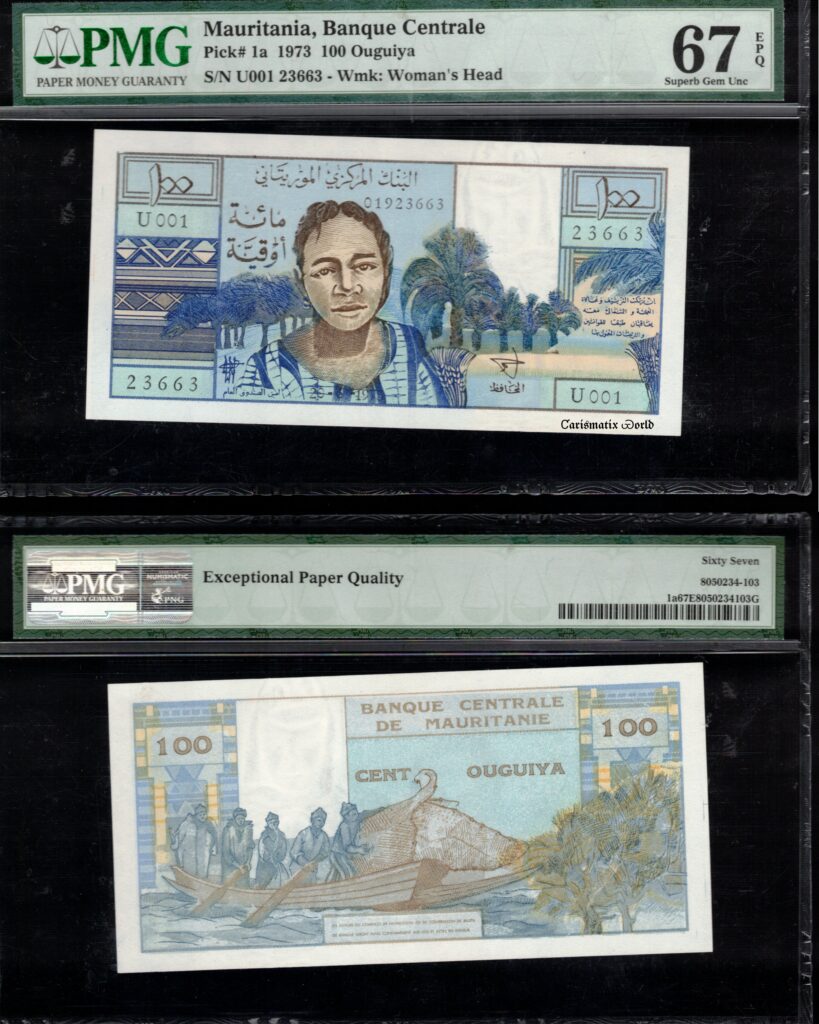
7. Features Unique to Mauritania: 5-Khoums Subdivision: Unlike the decimal currency system (10 or 100 subdivisions), the Ouguiya is divided into 5 Khoums, a system unique to Mauritania. Cultural Representation: The designs reflect Mauritania’s desert-based economy and strong Islamic influence.
Would you like help identifying specific banknotes, their value, or details on a particular design?
Nepal’s 1951 banknotes are an important part of the country’s financial history, marking some of the earliest issues of paper currency in Nepal. Here’s a detailed breakdown:
1. Issued By: The notes were issued by the Government of Nepal, as the Nepal Rastra Bank (the central bank) had not yet been established (it was founded in 1956).
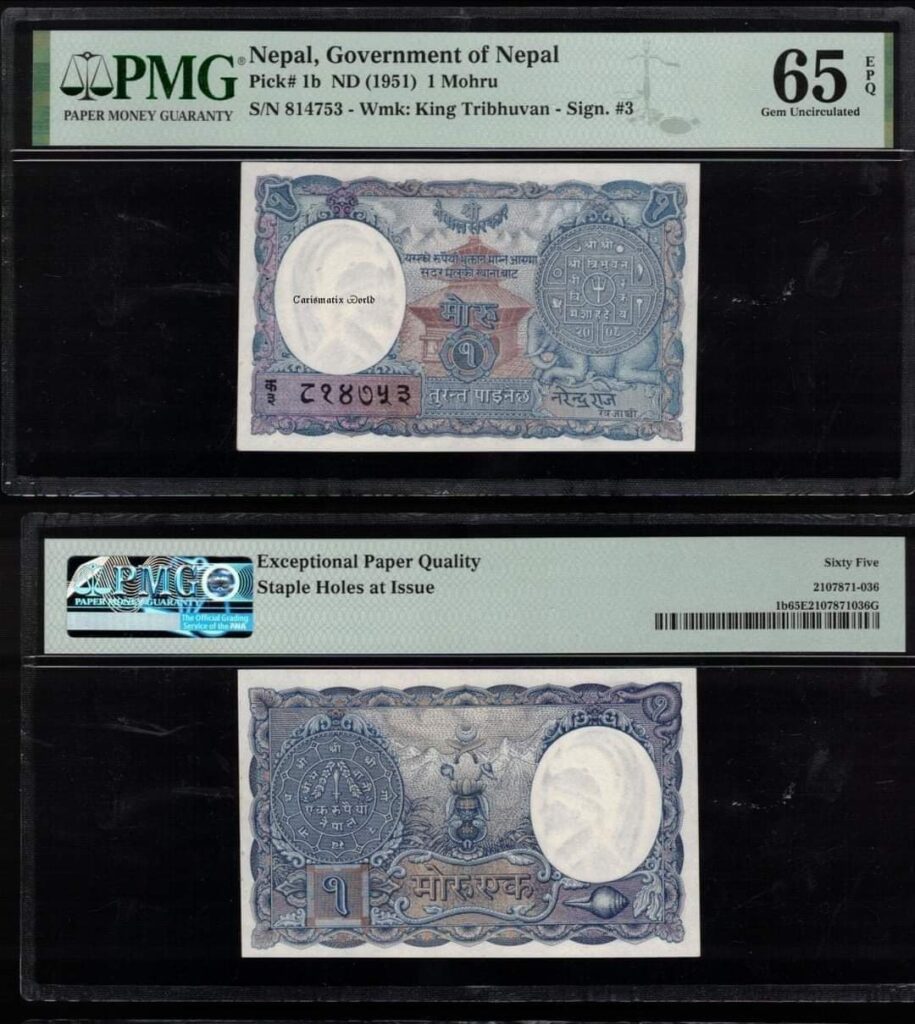
2. Currency Name: The currency was the Nepalese Rupee (NPR), which was introduced in 1932, replacing the silver Mohar as the primary currency.
3. Denominations: The 1951 banknotes featured denominations such as: 1 Mohru, 5 Mohru, 10 Mohru & 100 Mohru These were among the first paper currency series issued in Nepal.
4. Designs and Features:
- Obverse (Front): Featured a portrait of King Tribhuvan, who played a key role in Nepal’s move from the Rana autocracy to a democratic system in 1951. Included text in Nepali (written in Devanagari script) and some English for denomination labels.
- Reverse (Back): Depicted symbols of Nepalese culture and heritage, such as: Mountains (possibly referencing the Himalayas). Temples and religious motifs. The notes were printed with vivid colors and intricate details, though the designs were simpler than later issues.
5. Historical Context:
- King Tribhuvan’s Era: These notes were issued during the reign of King Tribhuvan, after he returned to power following the end of the Rana regime in 1951. They symbolize the transition to democracy in Nepal and the modernization of its financial system.
6. Collectors’ Value:
Historical Appeal: These notes have great historical and numismatic value due to their association with King Tribhuvan and Nepal’s early democratic reforms.
Rarity: The 1951 notes are rare and highly sought after by collectors, as they are among the earliest paper money issued by Nepal.
Condition: Crisp, uncirculated notes or those with unique serial numbers are worth significantly more.
7. Printing and Security: The notes were printed abroad, as Nepal did not have its own printing facilities at the time. Security features were minimal compared to modern standards, making these notes simpler in design.
If you’d like more details on specific denominations, designs, or their market value, let me know!

